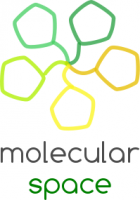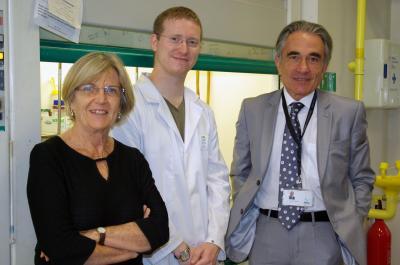
Enzyme map
Researchers
in Spain have used computational chemistry to plot for the first time a
"cartographic map" of enzyme behavior during the catalytic process.
Features include the moment when a given enzyme is at the point of maximum
energy on the way from taking reactants to final product, which all happens
within a femtosecond. The study conducted by researchers at the Universitat
Jaume I and the University of Valencia was published in Nature Chemistry.
"We can [now] make a quantitative estimate of the flexibility of the
protein, how much it deforms itself, how much energy you need to deform that
protein to generate the reaction that you want," explains UJI's Vicent
Moliner.
 Computational
chemistry draws for the first time the "interactive cartographic map"
of enzymes during chemical reactions
http://www.uji.es/UK/ocit/noticies/detall&id_a=33312503
Computational
chemistry draws for the first time the "interactive cartographic map"
of enzymes during chemical reactions
http://www.uji.es/UK/ocit/noticies/detall&id_a=33312503
Enzymes Make the World Go 'Round

We often talk about
reactions and the molecules that change in those
reactions. Those changes don't happen on their own. If you leave a blob of
protein in a Petri dish, will it
just break down to the
amino
acids? No. What will do it? Enzymes!
Enzymes are the
biological substances (proteins) that act as
catalysts and help
complex reactions occur everywhere in life.
Assembly Line Robots
You all know about cars and the assembly lines
where they are made. There are giant robots helping people do specific tasks.
Some lift the whole cars, some lift doors, and some just put bolts on. Enzymes
are like those giant robots. They grab one or two pieces, do something to them,
and then release them. Once their job is done, they move to the next piece and
do the same thing again. They are little protein robots inside your cells.
Enzymes complete very, very specific jobs and do nothing else. The robot
that was designed to move a car door can't put brakes on the car. The
specialized robot arms just can't do the job. Enzymes are the same. They can
only work with specific molecules and only do specific tasks. For example, you
might have a protein in a cell. Even with hundreds of amino acids in the chain,
the overall shape changes if one amino acid is different. That tiny shape change
could stop the enzyme from doing its job. Some
herbicides are
used to block enzyme activity. Plants have adapted by changing one or two amino
acids in the enzymes. They can continue to work with the correct proteins and
there is no bonding to the herbicides. In the same way that there are
specialized robots for different types of cars, there are enzymes for neural
cells, intestinal cells, and your saliva.
 There are four steps in
the process of an enzyme at work:
1.
There are four steps in
the process of an enzyme at work:
1. An
enzyme and a
substrate are in the same area.
The substrate is the biological molecule that the enzyme will work on.
2. The enzyme grabs on to the substrate at a special area
called the active site. Enzymes are very, very specific and don't just grab on
to any molecule. The active site is a specially shaped area of the enzyme that
fits around the substrate. The active site is like the grasping handle of the
robot on the assembly line. It can only pick up one part.
3.
A process called catalysis happens. Catalysis is when the substrate is changed.
It could be broken down or combined with another molecule to make something new.
4. The enzyme lets go. This is a big deal. When the enzyme
lets go, it returns to normal, ready to work on another molecule of substrate.
The first molecule is no longer the same. It is now called the product.
Enzymes
At any given moment, all of the work being done inside any cell is being done
by
enzymes. If you understand enzymes, you understand cells. A
bacterium like E. coli has about 1,000 different types of enzymes floating
around in the cytoplasm at any given time.
Enzymes have extremely interesting properties that make them little
chemical-reaction machines. The purpose of an enzyme in a cell is to allow the
cell to carry out chemical reactions very quickly. These reactions allow the
cell to build things or take things apart as needed. This is how a cell grows
and reproduces. At the most basic level, a cell is really a little bag full of
chemical reactions that are made possible by enzymes!
Enzymes are made from
amino acids, and they are proteins.
When an enzyme is formed, it is made by stringing together between 100 and 1,000
amino acids in a very specific and unique order. The chain of amino acids then
folds into a unique shape. That shape allows the enzyme to carry out specific
chemical reactions -- an enzyme acts as a very efficient catalyst for a specific
chemical reaction. The enzyme speeds that reaction up tremendously.
For example, the sugar maltose is made from two glucose molecules bonded
together. The enzyme
maltase is shaped in such a way that it
can break the bond and free the two glucose pieces. The only thing maltase can
do is break maltose molecules, but it can do that very rapidly and efficiently.
Other types of enzymes can put atoms and molecules together. Breaking molecules
apart and putting molecules together is what enzymes do, and there is a specific
enzyme for each chemical reaction needed to make the cell work properly.
You can see in the diagram above the basic action of an enzyme. A maltose
molecule floats near and is captured at a specific site on the maltase enzyme.
The
active site on the enzyme breaks the bond, and then the two
glucose molecules float away.
You may have heard of people who are
lactose intolerant, or
you may suffer from this problem yourself. The problem arises because the sugar
in milk -- lactose -- does not get broken into its glucose components.
Therefore, it cannot be digested. The intestinal cells of lactose-intolerant
people do not produce
lactase, the enzyme needed to break down
lactose. This problem shows how the lack of just one enzyme in the human body
can lead to problems. A person who is lactose intolerant can swallow a drop of
lactase prior to drinking milk and the problem is solved. Many enzyme
deficiencies are not nearly so easy to fix.
Inside a bacterium there are about 1,000 types of enzymes (lactase being one
of them). All of the enzymes float freely in the cytoplasm waiting for the
chemical they recognize to float by. There are hundreds or millions of copies of
each different type of enzyme, depending on how important a reaction is to a
cell and how often the reaction is needed. These enzymes do everything from
breaking glucose down for energy to building cell walls, constructing new
enzymes and allowing the cell to reproduce. Enzymes do all of the work inside
cells.
 Huw Davis, Emory University, USA, has received the the Best
Reagent Award for his widely used carbenoid precursor
Huw Davis, Emory University, USA, has received the the Best
Reagent Award for his widely used carbenoid precursor Huw Davis, Emory University, USA, has received the the Best
Reagent Award for his widely used carbenoid precursor
Huw Davis, Emory University, USA, has received the the Best
Reagent Award for his widely used carbenoid precursor






 We often talk about reactions and the molecules that change in those
reactions. Those changes don't happen on their own. If you leave a blob of protein in a Petri dish, will it
just break down to the amino
acids? No. What will do it? Enzymes! Enzymes are the
biological substances (proteins) that act as catalysts and help
complex reactions occur everywhere in life.
We often talk about reactions and the molecules that change in those
reactions. Those changes don't happen on their own. If you leave a blob of protein in a Petri dish, will it
just break down to the amino
acids? No. What will do it? Enzymes! Enzymes are the
biological substances (proteins) that act as catalysts and help
complex reactions occur everywhere in life.  There are four steps in
the process of an enzyme at work:
There are four steps in
the process of an enzyme at work: 

 Continuous-flow Diels–Alder reactions with a homemade HPLC column give good selectivity for >150 h
Continuous-flow Diels–Alder reactions with a homemade HPLC column give good selectivity for >150 h







 Enatiomers (−)-hyperione A and (−)-hyperione B can be
synthesised from a common precursor in ten steps
Enatiomers (−)-hyperione A and (−)-hyperione B can be
synthesised from a common precursor in ten steps




